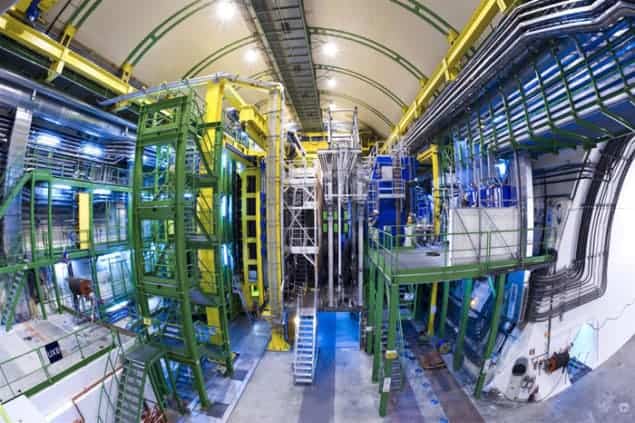
Two new particles have been discovered by physicists at the Large Hadron Collider (LHC) by sifting through data acquired in 2011–2012. The particles, called Ξb′– and Ξb*– are excited states of the Ξb– particle, which was first reported in 2007, and have half-lives that are tiny fractions of a second. The discoveries were made by physicists working on the LHCb detector and provide further evidence of that experiment’s ability to make extremely precise measurements of particle masses.
The Ξb– baryon comprises three quarks – the down quark from the lightest quark generation, the strange quark from the middle generation and the beauty (or bottom) quark from the heaviest one. Thanks to the large mass of the beauty quark, this baryon is more than six times as massive as the proton. In the baryon’s ground state its spin quantum number is 1/2, but two metastable excited states are also theoretically possible. The lower energy – and therefore lighter – state, the Ξb′–, occurs when the spins of the down and strange quarks point in opposite directions; whereas in the higher energy state, the Ξb*–, the spins of all three quarks are aligned.
Pion or photon?
Both of these metastable baryons are predicted by quantum chromodynamics (QCD) to decay to the ground state. The Ξb*– should decay extremely rapidly by emitting a Ξb0 and a bound quark–antiquark pair called a π-meson (or pion). Predictions of the decay of Ξb′– have been more difficult to calculate, with some physicists concluding that the particle has enough energy to decay in the same way. Others, however, argue that it does not have enough energy to decay via pion emission and instead decays by emitting a photon.
Now, the LHCb collaboration has resolved this debate by looking at events in which both a Ξb0 baryon and a pion had apparently been produced from the same point in the detector and at the same time. This is a challenge because the Ξb0 particle itself decays rapidly via the weak interaction, and the particles that actually appear in the detectors are its decay products.
By calculating the total kinetic energy of the Ξb0 baryon and pion, the researchers found two clear peaks in the spectrum – a high, sharp peak at around 3.7 MeV and a broader peak at about 24 MeV. Converting these energies to masses using Einstein’s famous equation E = mc2, the researchers calculated how much mass had been converted to energy during each decay. Adding this mass to the known masses of the pion and the Ξb0 baryon revealed the masses of the particles that had decayed to create the pair. The sharp peak at 3.7 MeV confirmed that the Ξb′– has just enough energy to decay via pion emission, whereas the 24 MeV peak is in good agreement with QCD predictions for the Ξb*– decay.
Lucky mass
“Nature was kind and gave us two particles for the price of one,” says LHCb physicist Matthew Charles of Paris VI University. “The Ξb′– is very close in mass to the sum of its decay products: if it had been just a little lighter, we wouldn’t have seen it at all using the decay signature that we were looking for.”
Measuring the widths of the peaks, the researchers estimated the lifetimes of the particles. The peak at 24 MeV, arising from the decay of the Ξb*– baryon, was much broader than the resolution of the detector. The spread of the measured particle-energy values therefore represents the fundamental quantum limit imposed by Heisenberg’s uncertainty principle on the accuracy with which one can determine the uncertainty of a particle that exists for a very small amount of time, and suggests that the particle has a half-life of about 4 ×10–23 s. The width of the narrower peak caused by the Ξb′– decay, however, was comparable with the detector resolution. The researchers can, therefore, only measure a maximum width for the peak, and thereby calculate a minimum existence time of 8 ×10–21 s. “We know [the particle] is longer-lived,” explains particle physicist and LHCb spokesperson Guy Wilkinson, “even though it’s still very, very short-lived in absolute terms.”
Exquisite instrument
Jonathan Rosner, a particle physicist at the University of Chicago who was not involved in the present work, helped predict the masses of the Ξb– excited states in 2009, concluding that the Ξb′– would be too light to undergo pion decay. He is surprised to see this peak and extremely impressed at its detection. “What impresses me – and it’s not just this result – it’s a whole host of results from the LHCb experiment,” he says, “is how exquisite an instrument it is, with incredibly good mass resolution.”
The research is described on arXiv.



